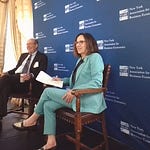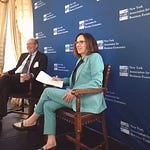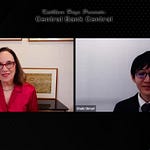Jim Bullard was never shy to think outside the box in his 15 years as president of the Federal Reserve Bank of St. Louis, where he started his central banking career as a research economist in 1990. Notably in 2022 in the middle of the pandemic when CPI inflation hit 9 pct, Jim was at the vanguard of Fed officials pushing to put their foot on the monetary policy brake and rev up to 75bp rate hikes. The Fed made its first of three jumbo hikes in July 2022 and inflation fell steadily from there.
Jim left the St Louis Fed in to become Dean of the Purdue Business School where he has continued to make his voice and views heard. Early in 2024 when inflation was much further above its 2% target than it is now, Jim said it was time to start cutting rates, predicting four such moves, which the Fed did by the end of the year.
Now, as the Fed has paused on its rate cut path, he is on board with this decision, and still sees possibly a couple more cuts this year.
As the Fed pauses on its 2024 rate cut path at its first meeting of 2025, Jim is inside the box with those who say the central bank now has made “the recalibration and now actually I think they're in great shape. So I think this was a good place to pause and and now they can go from here.”
Where he is once again outside the box - in fact way outside the box of the mainstream macroeconomists- is on President Trump’s policies, with tariffs at the top of the list.
”I just don't think that the talk about tariffs and inflation is well placed,” Jim says, “I think you could read monetary textbooks and macroeconomic textbooks for 30 years like I have, and you never see tariffs even mentioned once.”
So dive in and hear what Inside-the Box Jim Bullard has to say about the current Fed policy stance on pausing rate cuts now with an eye open to more rate cuts. And what Outside-the-Box former president of the St. Louis has to say about how Trump administration policies could have a beneficial impact on U.S. growth.
Right time to pause 00:00:54:23 - 00:01:22:11
Is this the right time to pause? I think it is. I think they've made the recalibration that they had to make from the peak of policy rates that they had. That peak policy rate was set in 2023 when inflation was much higher. So they've been looking all during 2024 for an opportunity to bring the policy rate down given that inflation had fallen.
Path ahead is clear for more rate cuts 00:01:48:06 - 00:02:32:07
They have really good growth. They have a good numbers on the labor market. And inflation is certainly way down from its peak, but still somewhat above target two, that's rationalizing where they are. And I think if inflation continues to come down a little bit, they have a move or two that they could make during 2025. So they've got that sitting there…. And if inflation doesn't come down, they can just stay out where they are. So this is pretty good, a pretty good position for monetary policy to be in given this configuration of data.
How restrictive is the current level of rates…well hard to tell 00:02:58:11 - 00:03:24:06
I think I think it's always a little bit hard to tease out sort of what the marginal effect of policy changes. But on inflation, inflation has been coming down. It has stalled out a little bit in the last part of 2024. And the committee will be looking for those numbers to come down closer to their 2% target.
R-star and high productivity growth; can it continue?- A0:03:26:20 - 00:04:17:08
another way of asking this question, restricted, not restrictive. You know, if the Fed funds rate is where it needs to be or if it needs to move even lower, we could talk about R-Star. We could talk about productivity. What does that tell us? …we did have a high productivity growth regime from 1995 to 2005, and it was pretty rapid productivity growth about 3% per year right now. And for the years since then, we've been in the low productivity growth rate, which is only about 1.3%. So are we shifting to the high productivity growth, which I think we all hope? The answer is yes.
A mixed Fed with an optimistic Chair 00:05:20:06 - 00:05:43:07
We know this this appears to be a federal Open market committee that has a wide variety of views to put it mildly. We've seen dissents last couple of meetings because inflation is not falling enough. And in fact, people are concerned that the upside risk is bigger than the downside risk. And clearly, Chair Powell seems to be maybe a little in the middle, but still towards, okay, let's go ahead and cut rates some more…
Bullard’s assessment of the Fed’s policy position 00:06:05:05 - 00:06:25:23
I think this was the right one. And they can afford to wait and see what happens with inflation before they make their next move. They're a little bit higher than they really have to be, but that should put more downward pressure on inflation than they would otherwise get. And so I think they're I think they're in pretty good shape.
Tariff uncertainty could harm growth at first 00:06:25:23 - 00:07:30:08
I would have supported this decision going forward. A lot of people have talked about, well, you know, Washington is abuzz with all kinds of new policy changes. Many of them, I think, will be pro-growth, I think on the tariffs question, I did live through the tariffs of 2018, 2019, and there I thought that the uncertainty created by a tariff for especially with China, where you weren't sure what the rules were going to be going forward. So up until the time that they reached a deal, that period was harmful to real economic growth because that can directly affect an investment. Who wants to make $1,000,000,000 investment when you're not sure what the rules are going to be? So everyone, I think - any rational player in that situation - would say, well, why don't I wait a few months and see if this settles down and then I'll make my billion dollar investment.
Keep the focus on real growth 00:07:30:08 - 00:07:57:02
I think that happened in the summer of 2019. So people have talked about the inflationary impact of tariffs, but the track record is that you have to be worried about the real growth side. So at that juncture, as I argued for lowering the policy rate to help us on the growth side. So I think that's something to keep an eye on in 2025 here.
45 months above the 2% target -is the Fed still credible? 00:09:02:01 - 00:09:44:06
<It’s> all about taking credible action and making it clear that the Fed is serious about inflation back to 2%. Now, could you linger too long at this above 2%? You certainly could. I think they've got time on that. What could be costly in terms of credibility is if core inflation went back above 3% and then the committee nevertheless decides to ease further or something like that, that would be, you know, that would raise a lot of questions about, well, how serious are you about the 2% inflation target?
The Trump administration is all about growth… 00:10:36:24 - 00:11:12:18
I think it's a pro-growth administration. They definitely have growth ideas in mind. They definitely want to have that be the metric for success. I think to me, that's a great thing and we'll see how successful they can really be with various policies. Washington's a tough place to navigate, but I thought also that the 2017 Trump administration was pro-growth and they had a good card to play on this, which was the reduction in the cap and trade and the corporate tax rate for the U.S., which was too high relative to international standards.
Taxes don’t cause inflation (Tariffs are a tax) 00:12:01:07 - 00:12:27:23
You know, I just don't think that's the talk about tariffs and inflation is well placed. I think you could read monetary textbooks and macroeconomic textbooks for 30 years like I have, and you never see tariffs even mentioned once. Why is that? Well, taxes don't cause inflation. Taxes are distortionary, but they don't cause inflation. And you might want to put tax on different situations
Tariffs…thinking outside the box 00:12:55:24 - 00:13:17:05
<case#1> And then and then the tariffs just stay at that high level. <case#2> But there's another outcome, a better outcome and a benevolent one and one that might really ratchet up U.S. growth, which is that the arrival does not react to it by raising their tariffs. They react to it by lowering their tariffs, and then the US takes the tariff off.
Is fear of fiscal deficits driving rates higher? 00:14:32:11 - 00:15:35:09
You wouldn't expect the yield curve to just remain inverted even in an environment where there's no recession on the horizon and inflation's been coming down. So I think we've returned to more normal pricing compared to ‘22 or ‘23, where markets were continually expecting a recession that never materialized. So I think that's in my mind, the explanation for why the ten year is trading where it is. And I expect the yield curve to get even a little bit steeper here, both at both ends, I guess. And I think that will be the full return to normality in that case. I don't think that that's necessarily coming from fiscal deficits, which surely are not news. I would challenge people that say, well, this is a news story, this has been a story for four decades and certainly a story in the lab since the pandemic.
Are rate hikes expected? 00:16:19:16 - 00:16:43:18
I think there's some probability that that could happen. I don't think it's a lot maybe sitting here today. Maybe I put 20% chance on that? So it's it's not that it's zero. It could happen. And I think the way it would happen would be that inflation core PC inflation goes back above 3% instead of staying below a little bit below 3%, which it has for recent months, it goes back above and it seems like it's not. It might even go higher from there. So I think in that situation you would get a community that would say, hey, we're not we're not going to allow that. And they would they would that would start a new type tightening cycle. Like I say, that's not the base case here…but I think traders should be aware that that that that possibly could happen.
Help community banks! 00:18:56:20 - 00:19:21:09
Well, there are many, many issues around bank regulation. And I think I think one of the things that I would stress is that the Fed has to continue to be a voice for community banks because they have ever since the financial crisis have been hit with a lot of regulation. That doesn't really make any sense at that level of banking.
James “Jim” Bullard is the former president and CEO of the Federal Reserve Bank of St. Louis. He became president on April 1, 2008, succeeding William Poole. On July 13, 2023, he announced he would be leaving the St. Louis Fed effective Aug. 14, 2023, to become the inaugural dean of the Mitchell E. Daniels, Jr. School of Business at Purdue University, effective Aug. 15, 2023.
Bullard is a noted economist and scholar, and his positions are founded on research-based thinking and an intellectual openness to new theories and explanations. As a participant on the Federal Open Market Committee, he was often an early voice for change. Of note:
Shortly after the U.S. declared the COVID-19 pandemic to be a national emergency and health authorities recommended a curtailment of economic activity, Bullard argued that the goals of macroeconomic policy should be different for this crisis than for a traditional economic recession. This economic crisis was directly related to the actions needed to contain the virus and invest in public health. As a result, optimal policy could be better described as maintenance and support—more a matter of insurance than traditional stimulus—with a focus on keeping disrupted households and businesses whole by providing relief during the pandemic adjustment period.
In 2016, Bullard announced a new approach for the St. Louis Fed’s near-term U.S. macroeconomic and monetary policy projections. The new approach is based on the idea that the economy may experience one of several possible persistent regimes, which involve a combination of recession or no recession, high or low productivity growth, and high or low real returns on government debt. While switches between regimes are possible, they are difficult to forecast. This contrasts with the more traditional approach to monetary policy projections, which assumes that the economy will converge to one single, long-run steady state.
Earlier in his tenure, Bullard warned about the possibility of a Japanese-style deflation in the U.S. His paper on this topic, published in 2010, helped move the FOMC’s thinking toward a second round of quantitative easing.
He argued strongly that the timing of monetary policy decisions, including interest rate policy or the pace of asset purchases, should be driven by incoming data on the state of the economy as opposed to the calendar.
During the financial crisis, Bullard also advocated for establishing an explicit inflation target, which the FOMC has since adopted. And he argued that the Committee should defend the target when inflation is below as well as above it.
In 2008, Bullard was an early voice on the potential consequences of zero-interest-rate policy. He argued at the time that the Fed might need to turn to quantitative measures of monetary policy in order to avoid deflation.
Bullard made public outreach and dialogue a priority to help build a more transparent and accessible Fed. He regularly engaged with many audiences—including academics, policymakers, business and labor organizations, charities, students and media, among other public groups—to discuss monetary policy and the U.S. economy and to help further the regional Reserve banks’ role of being the voice of Main Street.
A native of Forest Lake, Minn., Bullard received his doctorate in economics from Indiana University in Bloomington. He holds Bachelor of Science degrees in economics and in quantitative methods and information systems from St. Cloud State University in St. Cloud, Minn.
was chosen in July 2023 as the inaugural dean of the reimagined Mitchell E. Daniels, Jr. School of Business at Purdue University.
Bullard, was chosen in July 2023 as the inaugural dean of the reimagined Mitchell E. Daniels, Jr. School of Business at Purdue University and too the reins as the Dr. Samuel R. Allen Dean on August 15, 2023. He is charged with inspiring, further developing and implementing Purdue’s reimagined approach to a top-ranked business school across undergraduate, graduate, executive and research programs, preparing tomorrow’s business leaders and entrepreneurs in the Daniels School that is grounded in the principles of free enterprise, free market economy in generating opportunities and prosperity, and in the hallmarks of a well-rounded Purdue education and with a particular emphasis on tech-driven, analytics-based business success.
To further reflect and to maximize the impact of Bullard’s unique, national leadership experience, he also serves as Special Advisor to the President of the university, reporting to President Mung Chiang in that capacity. Bullard is also a Distinguished Professor of Service and Professor of Economics in the Daniels School.













Share this post